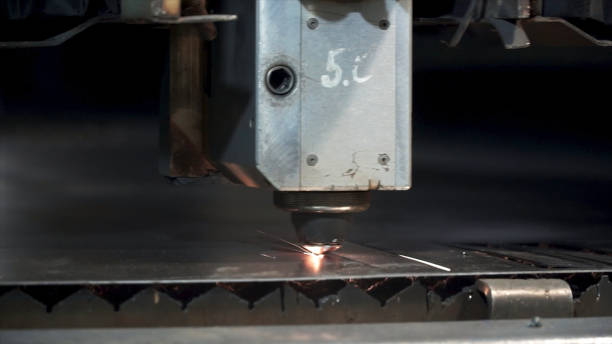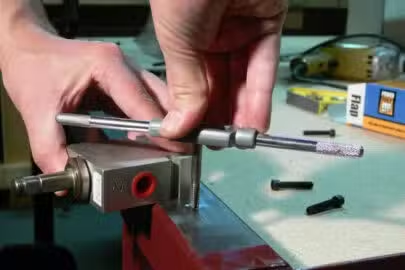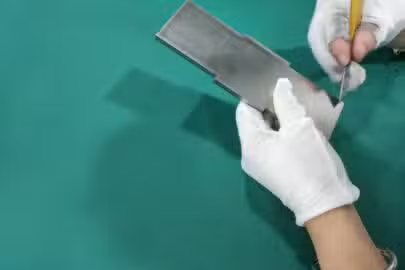Machining is an essential process in a variety of industrial applications, including the production of metal parts for automobiles and machinery, as well as specialized cutting tools. This technique uses specialized tools and equipment to cut, carve, or manipulate materials at the microscopic level. Engineers use a variety of machining methods to create the parts and components required for different projects and industries.
When traditional machining methods reach their limits, manufacturers frequently turn to electrical discharge machining (EDM). EDM is a popular non-traditional machining technique that employs electrical sparks to erode material and form precise shapes in hard materials. This process does not require or use mechanical force to remove excess material. EDM is widely used in the tool and die manufacturing, aerospace, medical, and automotive industries.
EDM is divided into two types: wire EDM and sinker EDM. This article will go over sinker EDM and wire EDM, including their principles, benefits and drawbacks, applications, and differences. We hope this helps you choose the best option for your manufacturing or EDM project.
What Is Sinker EDM?
Sinker EDM is a type of Electric Discharge Machining (EDM) method that uses an electric spark to create extremely precise blind cavities in conductive materials. A custom electrode sinks into a dielectric liquid and moves close to the workpiece without making contact.

When a high voltage is applied, a chain reaction of electric sparks between the electrode and the workpiece begins within that narrow gap. Sparks generate intense localized heat, causing material erosion. Sinker Electrical Discharge Machining, also known as ram EDM, cavity EDM, volume EDM, or plunge EDM, is primarily used to produce precise plastic injection molds, dies, and delicate parts.
Sinker EDM is especially beneficial in these applications because it cannot withstand the stress of conventional cutting forces. This technology is critical for manufacturing industries that require high precision and delicacy.
How Does Sinker EDM Work?
Similar to other forms of electrical discharge machining, sinker EDM operates based on sparks created by an electrical voltage differential between the workpiece and the electrode, the EDM tooling. These sparks’ high thermal energy melts or vaporizes portions of the workpiece and the EDM electrode. After that, the dielectric fluid washes the debris away.
Similar to other forms of EDM, the workpiece is effectively “cut” through by the thousands of sparks that occur every second. To “machine” the work surface to the required depth, the electrode is gradually sunk into the workpiece. When the tooling is removed, the workpiece is left with an inverted mirror image of the EDM tooling that was cut.
Sinker EDM typically uses a graphite electrode and a hydrocarbon oil, such as kerosene, as the dielectric fluid. Graphite electrodes and hydrocarbon oil balance tooling durability, surface finish, and cost, though other options are available for particular projects.
What Is Wire EDM?
Wire EDM is a non-contact subtractive manufacturing method that uses an electrically charged thin wire and a dielectric fluid to cut a metal part into various shapes.
Instead of cutting the material, the process melts or vaporizes it, producing small chips and precise cut lines. As a result, it can easily machine parts that are unsuitable for traditional machining techniques. However, the components must be electrically conductive.

How Does Wire EDM Work?
A dielectric liquid, a tool, a workpiece, and an electrical discharge machine are needed for electrical discharge machining. A voltage that produces a sequence of current discharges between two electrodes is necessary for the process. In this instance, the two electrodes are the metal workpiece and the metal tool, which are kept apart by the dielectric liquid (usually deionized water or hydrocarbon oil) and never come into contact with one another.
The machine precisely controls the gap, or spark gap between the tool and the workpiece. The operator increases the voltage during the EDM process, suddenly causing the liquid to transition from an electrical insulator to an electrical conductor. This process is known as dielectric breakdown. In the small area between the tool and the workpiece, this abrupt change creates an electric arc that erodes material from both electrodes.
The ultimate goal is erosion of the workpiece, but erosion of the tool needs to be carefully controlled. One way to do this is to replace the tool frequently with new metal sections. Beyond producing the electric arc, the dielectric fluid serves other purposes. The fluid removes metal fragments (similar to chips) from the workpiece in between current discharges, and fresh fluid is added. We call this procedure flushing. Different EDM versions have other functions. Although more specialized variations exist, such as fast-hole drilling EDM, this article focuses on a sinker and wire EDM.
Pros and Cons of Sinker EDM Machining
Here are the pros and cons of the sinker electrical discharge machining process:
Pros of Sinker EDM
- With accurate electrode machining, sinker EDM can produce precise, remarkable features.
- As a result, features can be precisely controlled. Unlike CNC machining, this process spares the tool from loads that could bend and deform it.
- Since sinker EDM doesn’t require a tool that is harder than the material being machined, it differs from other machining methods.
- Machining any conductive metal is possible with sinker EDM.
- Features like hexagon-shaped blind holes could be produced by it.
Cons of Sinker EDM
- Comparing the sinker EDM technique to other machining techniques like CNC milling, very little material is removed. The cost of each part is higher than it would be with alternative machining techniques due to the additional time required.
- Sinker EDM machines’ high-energy spark erosion process results in excessive electricity consumption. Much less energy is used by conventional CNC machines.
- Plastics and composites cannot be machined using sinker EDM; it can only handle conductive materials.
Pros And Cons Of Wire EDM Machining
Here are the pros and cons of wire EDM machining:
Pros of Wire EDM
- The machining process runs continuously and without interruptions. Even if the wire breaks while cutting, the process continues without interruption.
- Wire EDM cutting is best for fragile materials that cannot withstand the stress of machining.
- Complex forms and shapes that would be challenging to create with conventional CNC machining can be created with this approach.
- It creates clean, accurate cuts that do not require the workpiece to be further processed or finished.
- It facilitates the machining of tiny components and the cutting of intricate objects that would be too delicate for conventional machining techniques.
- The machine cuts materials without burrs or distortion after only one stage of processing.
Cons of Wire EDM
- Some materials, such as aluminum, may form an oxide layer on their cut surfaces. As a result, additional finishing may be required, increasing costs.
- It only works with materials that conduct electricity.
- It has a high initial investment and ongoing costs.
Applications of Sinker EDM
Since sinker EDM can generate intricate cavities, it’s beneficial when making molds, dies, and other types of tooling, especially out of hard materials like tool steel. It also produces deep ribs and sharp inside corners more effectively than other milling techniques. Here are the typical sinker EDM applications:
- Mold making
- Rapid Tooling
- Threads
- Dies
- Fine details
- Blind keyways
- Sharp inside corners
- Injection molding molds
- Deep and thin ribs
- Blind cavities
- Internal splines
Applications of wire EDM
Wire EDM is typically used instead of traditional machining processes to cut thick, hard metal plates. It is a popular method for producing punches, tools, and dies. Wire EDM produces a good surface finish while preventing part deformation. Here are the common wire EDM applications:
- Extrusion dies
- Parts where burrs are unacceptable
- Blanking punches
- Automotive and aerospace parts
- Graphite electrodes for sinker EDM
- Tight-tolerance parts
- Thick plates
- Medical and dental devices
- Thin parts that could break during conventional machining
What Are the Key Differences Between Sinker EDM and Wire EDM?
Here is a table showing the key differences between both processes, as well as a detailed comparison below:
| Sinker EDM | Wire EDM |
| The dielectric liquid is usually hydrocarbon oil | The dielectric liquid is usually deionized water |
| Movement principally along the Z-axis | Movement principally along the X and Y axes |
| The tool is usually made of graphite | The wire is usually made of brass |
| Ideal for tooling, molds, dies | Suitable for tooling, punches, dies |
| The shaped tool sunk into the workpiece from above | Thin wire cuts into the workpiece from the side |
Electrode Type and Material Removal
The unique electrode used in the Sinker EDM is usually made of graphite or copper and has a profile that mimics the desired cavity, or shape, within its workpiece. The procedure immerses both the electrode and workpiece in a dielectric liquid. Through erosion action, material is removed bit by bit as electrical discharges take place between the shaped electrode and the workpiece. This technique is especially useful for making complex shapes and contours in electrically conducting materials.
While, in the case of wire EDM, an electrically conductive thin wire is its electrode. This wire travels through the workpiece, involving forming a line perfectly following the program. Like in the case of Sinker EDM, the workpiece and wire electrode are immersed in dielectric fluid for this electrical discharge machining process. This method is extremely efficient for intricate and accurate cutting, particularly where tight tolerances are required.
Application and Geometry
Due to its ability to generate exceptionally complex shapes for molds and dies, Sinker EDM is ideal for applications that require intricate forms. This is due to its capability of creating complex geometries with great precision which makes it a preferred solution for manufacture of components that requires high detailing. Manufacturing flexibility is also enabled by this process as electrodes can be carefully customized to fit the shape of the targeted cavity
On the other hand, Wire EDM is especially effective in cutting small, intricate shapes and can be used to cut part accuracy that necessitates very tight tolerances. This continuous feeding of the wire enables production of complex parts with intricate shapes without resorting to custom tool adding efficiency and precision to manufacturing.
Process Speed
It is generally accepted that Sinker EDM, as compared to Wire EDM, is a much slower machining process. This feature renders Sinker EDM perfect for applications where exactness is preferred over speed in feeding materials. The control and precision of the process enable it to craft detailed features with great accuracy, however it may not be as time-save in cases where there is a high demand.
Meanwhile, wire EDM is widely known for its powerful cutting capabilities. The continuous feeding of the wire allows for increased material removal rate, which benefits Wire EDM for applications requiring high production speed especially when facing complicated designs and small miniature components.
Material Types
Sinker EDM displays a rich ability to process various conductive materials, which makes it suitable for hard metal applications such as tungsten carbide and different tool steels. Such flexibility enables manufacturers to use materials that other machining processes may find difficult to work with, thereby widening the field of application for Sinker EDM.
Contrastingly, Wire EDM is used for electrically conductive materials including metals and alloys. It is mainly used for machining hard materials and even those which have high tensile strength because of its ability to efficiently cut complex shapes.
Tooling and Electrode Considerations
Sinker EDM utilizes custom-shaped electrodes for each specific shape or cavity. These electrodes are carefully built to conform to the required geometry of the workpiece. This affords a high level of flexibility and accuracy but also necessitates dedicated tooling for every application. Moreover, this process could require electrode wear that requires adjustments and replacements at regular intervals.
The continuous wire itself acts as electrode in the Wire EDM. This removes the need for specific tooling of every shape, thereby simplifying setup and reducing change-over times. The presence of wear in Wire EDM is also distributed uniformly along the length of the wire, unlike localized wear on shaped electrodes using Sinker EDM.
Versatility
The versatility in shaping complex geometry using sinker EDM makes it apt for applications where intricate and customized designs are desired. It can be considered to be a useful feature in the sectors of tool and die making where accurate dimensions become very important. But the method could be less flexible in terms of production productivity, especially from a high-volume perspective.
Wire EDM shows flexibility in complex and accurate cutting, which makes it compatible with all kinds of applications that involve tight tolerances. The constant wire, used in this process, ensures that complex geometries are produced quickly and efficiently; they include prototyping as well as production runs. However, its speed and accuracy make it an excellent choice for applications that include aerospace components as well as medical devices.
Sinker EDM vs. Wire EDM: Which Process Should You Choose?
We’ve now covered the advantages and disadvantages of wire EDM and sinker EDM. You might be wondering which one is best for your machining requirements. A given application’s requirements will determine which of the two approaches is best.
Sinker EDM is most commonly used to produce dies and moulds to generate plastic injection molding cavities. But when it comes to low-volume production and exact accuracy requirements, wire EDM should take precedence. Of all the techniques available on the market, wire EDM is the most economical and time-efficient technology.
It is advisable to take into account the following elements when selecting between the two procedures:
- Cost: In general, wire EDM is less expensive than sinker EDM, which makes it a more economical choice in some situations.
- Part Geometry: Sinker EDM is better suitable for deep cavities or molds with complex geometries, whereas wire EDM is suitable for complex shapes with strict tolerances.
- Material Type and Thickness: While sinker EDM works well with thicker materials, wire EDM works better with thinner materials.
- Production Volume: Sinker EDM is more appropriate for lesser production volumes because it is generally slower than wire EDM.
- Surface Finish: Surface finishes produced by sinker EDM are harsher than those made by wire EDM.
Conclusion
In summary, an electrical discharge is used in the process of Electrical Discharge Machining (EDM) to modify the physical characteristics and shape of a material. To give you an overview of this machining method, we have covered Electrical Discharge Machining (EDM) and its two kinds in detail in this article. With this knowledge, you should be able to choose the solutions that is suitable for your needs and achieve the best outcomes.To provide you with the best results with the highest precision and the shortest lead time, Zintilon offers the best wire EDM services. Order now and your merchandise will be delivered to your company address. For technical assistance, contact our engineers so you are clear on every step and feature.




